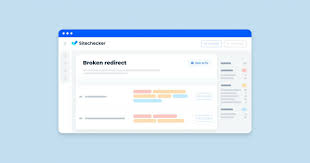
16
Broken Link? Here’s How Germany Checks Redirects with Ease!
Broken links and faulty redirects can hinder user experience and harm SEO performance. In Germany, checking redirects is made simpler with advanced tools and practices. This article explores how to identify and fix broken links efficiently, ensuring seamless website navigation and improved search rankings.
In the digital world, broken links and improper redirects can damage a website’s credibility, reduce search engine rankings, and frustrate visitors. For businesses and individuals in Germany, mastering the art of checking and fixing redirects is essential for a smooth online presence. This guide provides actionable insights and tools tailored for the German market to simplify redirect management.
1. Why Broken Links Matter
Broken links occur when a URL no longer leads to its intended destination, often resulting in a 404 error page. These issues can:
- Hurt SEO rankings, as search engines penalize poor site navigation.
- Diminish user trust, leading to higher bounce rates.
- Interrupt conversion funnels, reducing sales or leads.
Redirects, when done incorrectly, can exacerbate these problems, creating loops or redirect chains that confuse both users and search engines.
2. The Importance of Redirects in Germany’s Online Landscape
Germany's digital ecosystem is highly competitive, with businesses focusing on delivering flawless user experiences. Proper redirects ensure that:
- SEO value is preserved during domain changes or migrations.
- Users are directed to the correct localized pages, such as .de domains.
- Websites comply with GDPR guidelines, especially for EU-based visitors.
3. Types of Redirects Commonly Used
1. 301 Redirect (Permanent)
Transfers link equity to the new URL and is commonly used in site migrations.
2. 302 Redirect (Temporary)
Temporarily forwards users while keeping SEO value on the original URL.
3. HTTP to HTTPS Redirect
Crucial for security and building trust among users in Germany, where GDPR compliance is vital.
4. Geolocation-Based Redirects
Redirects users to country-specific pages based on their IP address.
4. Tools to Check Redirects Online in Germany
1. WebTigersAI Redirect Checker
A reliable tool for German users, WebTigersAI delivers precise insights into redirect chains, HTTP status codes, and potential issues.
2. Screaming Frog SEO Spider
Popular among SEO experts in Germany, this tool provides comprehensive website audits, including redirect checks.
3. Ahrefs Redirect Checker
A premium tool that identifies broken links, redirects, and other site issues.
4. Redirect Detective
A user-friendly solution for tracking multi-step redirects and detecting loops.
5. HTTPStatus.io
Ideal for analyzing batch redirects, offering detailed HTTP status code information.
5. Step-by-Step Guide to Checking Redirects in Germany
Step 1: Identify the URL to Test
Select the URL you suspect has a redirect issue or broken link.
Step 2: Choose a Redirect Checker Tool
Pick a tool based on your needs. For German users, Screaming Frog or WebTigersAI is recommended.
Step 3: Analyze the Results
Pay attention to:
- Redirect chains (multiple redirects before reaching the final URL).
- HTTP status codes, such as 301, 302, or 404.
- The final destination URL’s relevance.
Step 4: Fix Identified Issues
- Replace broken links with functional URLs.
- Update temporary redirects to permanent ones, if necessary.
- Consolidate multiple redirect hops into a single step.
6. How Germany Fixes Broken Links
Fixing broken links is a priority for German websites aiming to rank higher on search engines like Google.de. Here’s how it’s done:
- Audit regularly: Use tools like Screaming Frog to scan your website for broken links.
- Replace outdated links: Redirect old URLs to new pages or remove irrelevant links.
- Monitor internal links: Ensure all internal navigation points to valid URLs.
- Check for HTTPS compliance: Redirect HTTP pages to their HTTPS counterparts.
7. The Role of GDPR in Redirect Management
In Germany, GDPR compliance is non-negotiable. Proper redirects help ensure:
- Users land on privacy-compliant pages, especially for cookie policies or opt-in forms.
- Data transfers through secure HTTPS connections, building user trust.
8. Common Redirect Issues in Germany
1. Redirect Loops
A URL redirecting back to itself or creating an endless cycle.
2. Incorrect Language Redirects
For multilingual websites, users may land on pages in the wrong language.
3. Slow Redirect Chains
Multiple redirects in a chain can slow down website loading times.
9. Best Practices for Managing Redirects in Germany
- Use 301 redirects for permanent changes: Preserve link equity during migrations.
- Optimize geolocation redirects: Ensure users are directed to the correct .de pages.
- Monitor HTTPS redirects: Maintain security and SEO rankings.
- Avoid long chains: Aim for direct redirects to improve speed.
10. The Future of Redirect Management in Germany
As technology evolves, the focus on seamless user experiences and faster website loading times will intensify. Tools powered by AI and machine learning, like WebTigersAI, will continue to simplify redirect verification, ensuring German websites remain competitive.
Conclusion
Broken links and faulty redirects don’t have to be a headache. By leveraging advanced tools and following best practices tailored to the German market, you can maintain a high-performing, user-friendly website. Whether you're a business owner, SEO professional, or casual blogger in Germany, understanding how to check and fix redirects is key to improving user experience, preserving SEO value, and staying ahead in the digital landscape.
Contact
Missing something?
Feel free to request missing tools or give some feedback using our contact form.
Contact Us